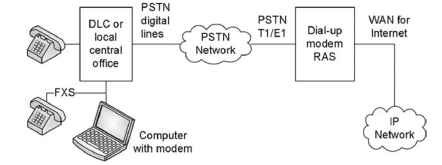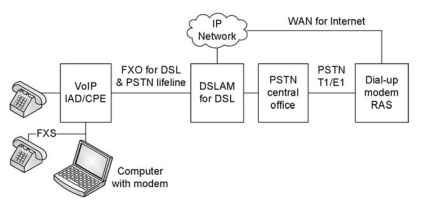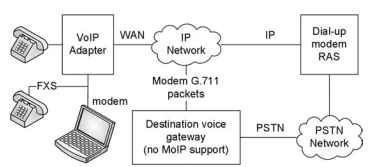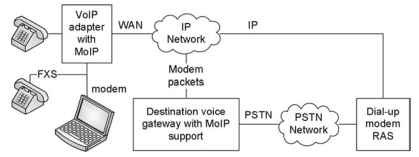15.8
A telephone is used along with a VoIP adapter and gateways for voice communication on IP. A fax may also use the same telephone interface of the adapter. A dial-up modem was used on telephone lines along with a computer for Internet connectivity. The use of a modem through the same telephone interfaces of the VoIP system is also possible. The modem is usually part of a PC or laptop or is external to the computer. The modem inside the computer

Figure 15.5. Functional PSTN setup to connect the PC modem for Internet connectivity.
will have a telephone interface. An external modem will have a computer interface for data connectivity on the one side and a telephone interface on the other side. VoIP adapters and integrated access devices (IADs) will have multiple interfaces for broadband connectivity as given in topic 2. Internet connectivity is extended directly through broadband interfaces instead of a modem. Dial-up modem connectivity through a telephone interface has limited use in VoIP adapters and gateways. Hence, modem connectivity through a dial-up modem did not gain much popularity. In the following sections, an overview on modem connectivity for migrating the PSTN to VoIP infrastructure is given. While writing this section, the end users were not using MoIP service.
15.8.1
Modem Simple Connectivity Through an FXO
Some VoIP IADs has digital subscriber line (DSL) for wide area network (WAN) Internet connectivity. DSL will use a PSTN line, and IAD may use a foreign exchange office (FXO) interface for PSTN lifeline support. On dial-up modem requirements, a dial-up modem can reach the FXO line directly. A VoIP IAD will simply switch the dial-up modem connected on the foreign exchange subscriber (FXS) port to FXO. Some prefix dialing digit could create FXS-to-FXO switching. This switching works similarly to the dial-up modem directly connected to the available telephone interface. As shown in Fig. 15.6, an FXO interface will reach the DSL service DSL access multiplexer
(DSLAM). DSLAM will split wideband DSL signals and PSTN signals. PSTN
calls are routed to the nearest or local central office. Usually RAS servers are located as local numbers and are mapped to a local telephone exchange. Supporting this dial-up modem through a PSTN interface will not be difficult, and the performance would be the same as a PSTN-based dial-up service, assuming foreign exchange subscriber (FXS), FXO front-end interfaces, and switching are working properly. Figure 15.6 is shown for the possibility of dial-up calls through IADs with a DSL interface. This type of dial-up modem scheme is given to provide an overview. When VoIP IAD is used, IAD will have several

Figure 15.6. Dial-up modem connections through an IAD FXO interface.
wideband network interfaces as shown in topic 2. The user may not find a significant benefit out of another dial-up service that gives a low data rate service telephone interface.
15.8.2
Modem Connectivity Through a VoIP Pass-Through
In the mode of G.711 pass-through, a modem call will use a VoIP voice call similar to fax pass-through G.711 compression. For dial-up purposes, a call can be routed to the nearest voice gateway that has access to a local PSTN. The gateway and VoIP adapter will not be negotiated for a modem over an IP call. At the VoIP gateway, a call will be passed to the FXO interface from the VoIP adapter similar to a VoIP-to-FXO call. From the voice gateway, a call is routed to the nearest RAS as shown in Fig. 15.7 . The dial prefixes and local number mapping in the destination voice gateway resolve routing the call to the RAS modem. Once a call is connected to RAS mode, it responds with an /ANS or ANSam modem tone. However, modem tones are detected at the gateway and VoIP adapter for arriving at the right configurations of a G.711 modem pass-through call. If a modem tone with phase reversal is detected, an echo canceller has to be disabled. An echo canceller up to 128 ms is used at the gateway in a normal FXO-to-VoIP modem pass-through call. In Fig. 15.7, a line marked with IP is also shown for joining the RAS to the IP network. The RAS is connected to the IP network for data communication.
15.8.3
Modem over IP in the VoIP Gateway
The modem relay over IP or MoIP [ITU-T-V.150 (2003) . URL (Surf-com) . URL (Cisco-modem), URL (Tldp-modem)] is mainly governed by V.150.1 [ITU-T-V.150.1 (2003)]. The purpose is to send modem data in IP packets and finally on the PSTN interface. In this mode of operation, the voice adapter will have a built-in MoIP function. The VoIP adapter takes an analog signal from

Figure 15.7. RAS modem with VoIP pass-through.

Figure 15.8. RAS built inside the voice gateway as MoIP.
the modem and performs certain functions of RAS locally within the VoIP adapter. Modem data bytes are sent as IP packets that will reach the destination gateway. The destination gateway will decode the MoIP packets and regenerate modulations and other messages on the PSTN interface. The RAS on the PSTN interface will work similar to a modem call received from the PSTN dial-up modem. The setup in Fig. 15.8 is a functional representation. Usually a RAS modem can be part of the destination voice gateway without going through another PSTN interface to the RAS, and a separate RAS modem may not be required. A failed MoIP call may revert like a G.711 pass-through call, and the destination voice gateway routes the call to a RAS modem. The functionality will be similar to Fig. 15.7, which shows the modem pass – through mode of operation.
An MoIP call may be established in multiple phases. Initially a modem call will progress as a voice call. On detecting modem tones and V.8 signals, the codec has to switch to G.711 from any other compression codec like G.729A. After exchanging messages between VoIP gateways and end modems, the call is switched to the MoIP call. An MoIP call uses packets and payloads similar to fax over IP calls.
